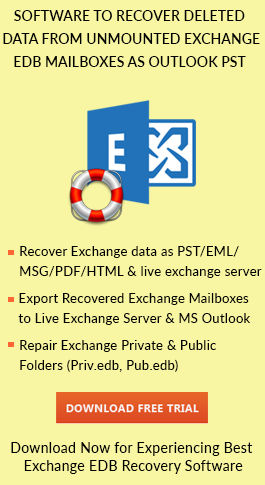Troubleshoot Exchange Database Corruption Using Eseutil Tool
Aisha Winget | February 8th, 2018 | Exchange
Microsoft Exchange server users are provided with an Eseutil utility to deal with corrupt EDB file. This tool is used to rescue all of the errors caused due to corruption. The application can be utilized when issues are related to corruption or soft/hard database restoration. However, few tips for troubleshooting the Exchange Server 2010 & 2003 database corruption via Eseutil or utility needs to be employed for a successful restoration. This blog will guide users through complete process description to fix Exchange database corruption using Eseutil tool.
Have a Quick Glance on Eseutil Utility
It is the restoration tool, which is inbuilt in the Exchange server. The storage path of this command line on the local machine is C:\Program Files\Exchsrvr\Bin directory. Functioning of the free tool is designed in a way that it understands the enterprise of the Exchange databases and blocks the data. It is having the capability of repairing, checking and compressing the primary storage file of MS Exchange server. Eseutil keeps a constant analysis of the Exchange data, which is stored in the records and tables of EDB file. Overall, it can be considered as database utility to tackle with database file errors. There are some prerequisites for utilizing and implementing this tool to fix Exchange database corruption. These prerequisites are explained in next section so, let’s continue!
Prerequisites Prior to Eseutil Utility Usage
Following points will help one learning all the things required for using Eseutil tool :
- A user needs to login as the Microsoft Exchange administrator
- Running or inaccessible database file should be backed up
- EDB database file should be dismounted from Exchange server
- Enough amount of free space should be available isn PC drive
- Use CHKDSK tool for checking bad sectors of system hard disk
- Both the STM as well as EDB files should be present on machine
Note : Alternatively, one can take help of following steps to Eseutil.exe utility from DOS command prompt :
- Go to Windows Start button and open Run window on your machine
- In the text box, type cmd and then press Enter button from keyboard
- Navigate towards the location of Eseutil tool i.e., C:\Program Files\Exchsrvr\Bin
- At last, type Eseutil.exe in the command line
Different Command Line Options to Fix Exchange Database Corruption
Several numbers of ESEUTIL switches are available in the Exchange server. Users should utilize them at various stages to fix physical EDB file structure. Explanation of each switch is available in the following table :
| Eseutil Switch | Operation |
|---|---|
| /? | It will be displaying complete options of Eseutil utility |
| ESEUTIL/d | This switch is used to defragment database offline and compact the selective database. |
| ESEUTIL/r | The switch functions by performing soft restoration and brings particular database in the consistent state. |
| ESEUTIL/g | It is executed to exhibit an integrity checking on mentioned database. |
| ESEUTIL/k | This is used to carry checksum testing on all the database pages. |
| ESEUTIL/p | The ESEUTIL/p command is used to repair damaged EDB files. |
| ESEUTIL/m | It dumps the header part of database file, log file, and the checkpoint file. |
| ESEUTIL/y | The command is used for copying large file in an effective way with a high performance. |
| ESEUTIL/c | This operation performs the hard database restoration during the online backup. |
Note: The ESEUTIL comprises of two file repairing switches i.e., r and p. The ESEUTIL/r switch is used to tackle with the low-level corruption of EDB file whereas ESEUTIL/p is used to deal with severely corrupted Exchange database file. Rest all other switches are used for restoration purpose, which means that they are also equally important.
Why there is a Need to Use ESEUTIL Tool?
When there is corruption in the physical structure of Exchange database files, administrators are suggested to use this utility. This fixes different errors like checksum error, invalid page number, invalid pointer, etc. Following steps need to be followed to implement this free Exchange utility :
- Regularly take backup of Exchange database
- ESEUTIL/d command should be executed
Note: This is suggested when the corruption occurs in white space of the Exchange database file. It is so because white space gets discarded on defragmentation. - ESEUTIL/p should be executed for repairing the database file
- After the successful execution of above command, execute ESEUTIL/d switch
After executing the commands one-by-one, now you have to check the physical structure of the database. This is required to verify where the file is repaired successfully or not. Take help of following guidelines for this :
- Mount and then dismount the database
- Check the consistency of database by using ESEUTIL/uh command
- Run ESEUTIL/k command to check the existence of page-level error
Note: The successful outcome of this repairing operation denotes that there is no more presence of bad checksums and wrong page numbers are present.
What Are the Conditions in Which ESEUTIL fails?
ESEUTIL utility demands STM, EDB files, and streaming media files for the proper functioning. If the administrator wants to use MS Outlook email client then, there are fewer chances STM with EDB or transaction log files will be present. In such case, it almost becomes impossible to fix Exchange database corruption. Not only this but, there are many conditions in which this utility fails to fix corruption.
Conclusion : What If ESEUTIL Fails?
As per discussed that there are chances that ESEUTIL utility might get failed. In such scenario, the only choice left is to opt for a third party application. One such program is EDB to PST Converter, which is the simple and easy solution to fix Exchange database corruption. The software is choice of many Exchange administrator around the world and is listed as an alternative to ESEUTIL tool.
